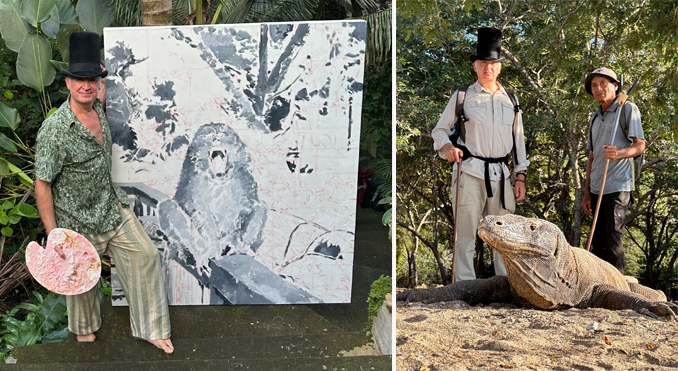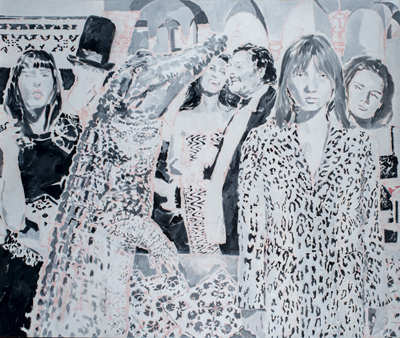
by Debbie Tuma
Southampton artist Kevin Berlin has always been motivated to paint his subjects first hand, believing he had to be there to tell the story. He moved to Soho in the 1990’s to paint New York’s nightlife—bodyguards, bartenders and women in little black dresses. In 2003 he moved to Russia to paint ballerinas on the 300th anniversary of Saint Petersburg. In 2022 Berlin held a show at the Hamptons Fine Art Fair of over 60 paintings of fresh tomatoes from his journey to Tuscany and Sicily.
And this year, he canceled his summer in the Hamptons to set up a studio at the edge of a jungle in Ubud, Bali, to paint endangered animals and Buddha statues, as well as practicing yoga, dance and healing arts. He could have lived in one of the villages, but he chose to rent a small villa in a remote area, surrounded by exotic birds and orchids, where he could live up close with nature and animals.
“I have always been interested in large animals, especially, and I studied zoology at Yale University and University College of London,” he said. “While dividing my time between Southampton and Florence, Italy, I decided to move to Bali, where I could take trips to exotic places to paint endangered animals, like Siamese Crocodiles in Cambodia, Asian Elephants in Sri Lanka, and Komodo Dragons, the world’s largest land lizards, in the Komodo Islands in Indonesia.”
Out of this six-month adventure, Berlin managed to capture all these apex predators and other animals on large canvases and also on smaller works on paper, which he is about to show for the first time at his new solo exhibition, called “CROC WEEK 2024!!,” on December 19, from 6 to 8 p.m., at Palm Beach Art, Antiques, and Design Showroom at 500 N. Dixie Highway in Lake Worth, Florida. The exhibition, which runs through January 15, 2025, is highlighted with large paintings called, “Croc in the House,” ‘Croc on Mars,” and the monumental canvas, “Elephant in the Room.” Small works on paper include those painted from life at the Siamese Crocodile Breeding Center in Cambodia, and the Elephant Transit Home in Sri Lanka. The opening night will feature special guests in conservation.
Berlin’s “CROC WEEK 2024!!” takes a fresh look at Siamese Crocodiles which were once feared extinct in the wild until their rediscovery in 2000. Fauna and Flora International, working with the Cambodian Government, established the country’s first captive breeding program and have released 196 crocodiles in the wild since 2012. They are bred in captivity due to threats from poaching and habitat loss.
“The other reason the crocs are going extinct is because they’re taken out of the wild, and raised on farms to make fashion accessories, which aren’t even good quality,” Berlin noted. He said like the Tyrannosaurus Rex, these crocodiles are one of the apex predators that have been around 100 million years. “They’re a living dinosaur, and extremely dangerous,” he explained.

So why is Berlin being allowed to get close and personal, to paint these croc creatures, and why does he do it? “I’m doing this, with all these large endangered animals, to raise awareness, to raise the conversation,” he said. “Where should they be? In my paintings, I have these giant crocs, and elephants, at a house party, surrounded by people in a room where they’re not supposed to be…. to point out the absurdity of it all. It’s slightly irreverent and the opposite of what you might expect. And the people in the room, who are the artist’s friends in real life, don’t even seem to notice.
Berlin did the same thing with the Komodo Dragon — the largest lizard, which is extremely venomous, at about 12 feet, and it can outrun a race horse for short distances. “They only live in the Komodo Islands, off Indonesia,” he said. “I went with a guide, who protected the dragon and me. It’s a UNESCO World Heritage Site and I had to get special permission from them to paint one of the rarest animals on earth.” “We searched for a dragon that would stand still long enough for me to paint, but fortunately the dragon I chose was more interested in warming himself up in the sun, than killing me. So I was able to paint,” he said.
During his trips to remote locations in Bali, Cambodia and Sri Lanka, Berlin said he had the privilege of painting some of these endangered animals, “looking eye to eye with a hungry predator, or into the gentle eyes of an Asian elephant, which are also at risk in Sri Lanka.”
“By having these authentic experiences and seeing these animals in their natural environment, I went back home and brought them to my environment, and invited them to meet my friends, in the form of a painting,” Berlin explained. “Now I am sharing this with the rest of the world, and these paintings are being unveiled in Lake Worth where many Hamptonites are wintering, and what better place than Florida, where they have crocodiles and alligators?”
Summing up his experience, Berlin concluded, “People and crocs have a lot in common—we all want to live in a beautiful place, we all want to have friends, and be loved, to build something and watch it grow, to be part of the future. And this is also true of crocodiles.” You can visit his website at www.kevinberlin.com
